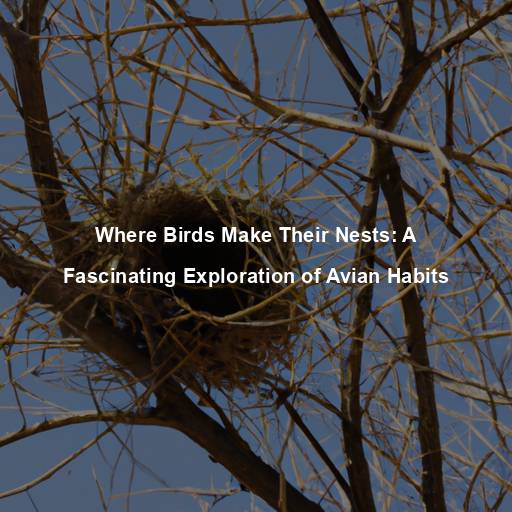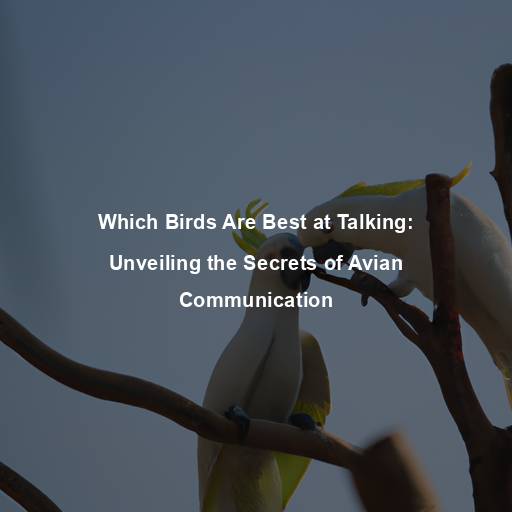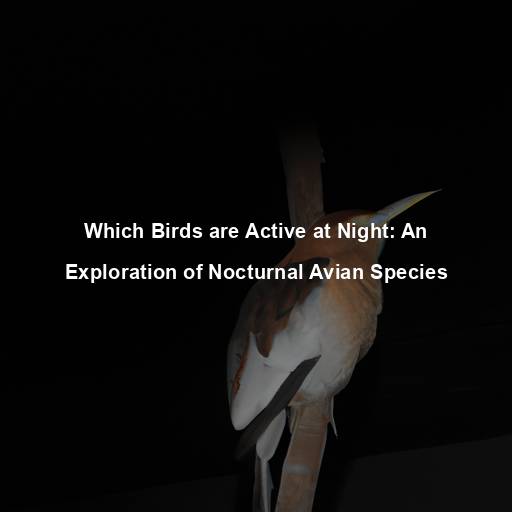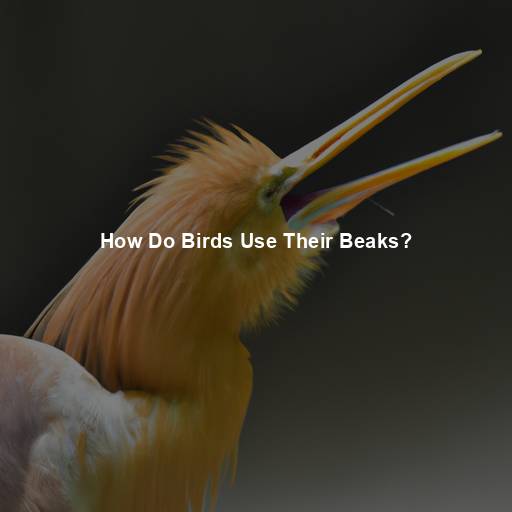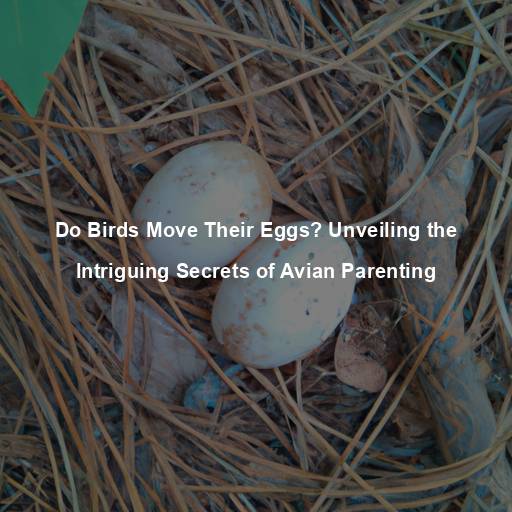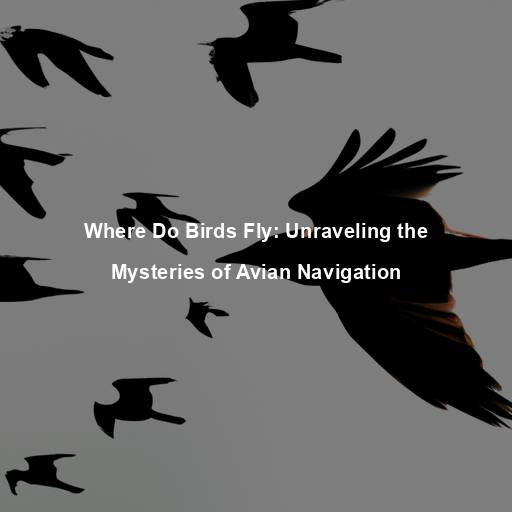Where Birds Make Their Nests: A Fascinating Exploration of Avian Habits
Last Updated on November 6, 2023 by Evan
Contents
- 1 Understanding the Importance of Nesting for Birds
- 1.1 The Evolutionary Significance of Nest Building
- 1.2 Nests in Natural Habitats
- 1.3 Materials and Construction Techniques
- 1.4 Challenges and Adaptations
- 1.5 The Wonders of Bird Nesting: A Testament to Nature’s Ingenuity
- 1.6 Nest Modifications and Repairs
- 1.7 Nesting Challenges in Changing Environments
- 1.8 Nest Predators and Defense Mechanisms
- 1.9 Captivating Nesting Adaptations
- 1.10 Conservation and Nesting Habitat Preservation
- 1.11 The Enduring Beauty of Bird Nesting
- 2 FAQs – Where Birds Make Their Nest
- 2.1 How do birds choose where to build their nests?
- 2.2 Do all birds build nests?
- 2.3 What materials do birds use to build their nests?
- 2.4 How long does it take for birds to build a nest?
- 2.5 Can birds reuse their nests?
- 2.6 How high do birds typically build their nests?
- 2.7 Do birds always build their nests in trees?
- 2.8 How can humans help birds with their nesting needs?
Understanding the Importance of Nesting for Birds
Throughout the ages, from the gentle chirping of early dawn to the breathtaking sight of colorful feathers dancing against the sky, birds have never ceased to mesmerize us. Whether by design or instinct, their nesting habits have always puzzled us humans. In this captivating journey, we embark on a quest to unlock the secrets behind their intricate dwellings. Join us as we unravel the enigmatic world of bird nesting, revealing the surprising array of materials and unconventional locations these winged architects choose to call home.
The Evolutionary Significance of Nest Building
Nesting is an essential aspect of avian life, serving multiple crucial purposes. Firstly, nests provide a safe haven for birds to lay their eggs and raise their young. By constructing nests, birds ensure the protection and survival of their offspring. Secondly, nests serve as a territorial marker, signaling to other birds that the area is already claimed.
Nests in Natural Habitats
Birds, fascinating creatures that they are, never cease to amaze us with their innate ability to find the most peculiar spots for their nests. It’s as if each bird has a secret realm of preferences, tailored just for them, depending on their surroundings and peculiar needs. So, brace yourself for a captivating journey as we delve into the myriad habitats where these winged marvels craft their humble abodes. Witness the bewildering diversity as we unfold the intriguing tales behind each avian species’ choice of nesting grounds.
Forests and Woodlands
Forests and woodlands teem with avian activity, with countless species finding their nesting sites amidst the lush foliage. Here, birds often build their nests in the crooks of tree branches, utilizing twigs, leaves, moss, and even spiderwebs to create secure structures. Some species, such as woodpeckers, excavate cavities in tree trunks for their nests, providing additional protection from predators.
Grasslands and Savannas
In open grasslands and savannas, birds face unique challenges in constructing nests that blend with their surroundings. Many ground-nesting species, like the iconic ostrich or the killdeer, create shallow depressions in the soil, skillfully camouflaging their eggs. Others, such as the weaverbirds, meticulously weave intricate nests from grass blades and twigs, suspending them from sturdy branches high above the ground.
Wetlands and Marshes
Wondrous wetlands and captivating marshes harbor a treasure trove of nesting prospects for exquisite avian species perfectly suited to these aqueous abodes. Majestic herons, elegant egrets, and captivating ibises ingeniously craft their nests among the verdant branches of emergent vegetation or painstakingly build platforms using a mosaic of sturdy sticks and sinuous reeds. These elevated sanctuaries serve as a shield against the capricious tides and stealthy predators lurking beneath the shimmering surface, creating a haven of security and serenity for these bewitching feathered creatures.
Coastal Areas
Coastal regions attract a wide array of seabirds and shorebirds, each with its unique nesting habits. Some species, including gulls and terns, create simple nests on sandy beaches or rocky cliffs. Others, like puffins, burrow into the soil or use underground crevices to raise their young. These nesting sites offer protection from strong winds and predatory threats.
Urban Environments
In the hustle and bustle of city life, birds have astoundingly mastered the art of survival, infiltrating our concrete jungles with their cleverness and resourcefulness. Unfazed by the towering giants of steel and glass that surround them, these avian beings have embraced the urban chaos as their own. Swapping the solidarity of trees for the hidden corners of towering buildings and cozy nooks of suburban dwellings, they defy expectations and establish their humble abodes amidst our concrete landscapes. From humble pigeons to dainty sparrows and swift swallows, these feathered urban dwellers have not only adapted but thrived, ingeniously wrapping their nests with our own discarded fragments.
Materials and Construction Techniques
The materials birds use to build their nests are as diverse as the habitats they inhabit. These resourceful creatures make use of a wide array of natural and man-made materials, showcasing their ingenious construction techniques:
Natural Materials
There is an intriguing world out there where birds tap into the wonders of their surroundings for their housing needs. Twigs, leaves, moss, grass, and feathers become their peculiar but essential construction elements. Yet, some avian species, like the captivating bowerbirds, push the boundaries of creativity by incorporating vibrant flowers, enticing berries, and even mesmerizing snail shells into their architectural masterpieces, captivating the attention of potential partners with their mesmerizing artistic exhibitions.
Man-Made Materials
In this ever-evolving world we inhabit, something quite fascinating is occurring among our avian friends. Birds, in their infinite brilliance, have found a way to repurpose the remnants of our human existence into their own humble abodes. Be it the alluring allure of strands of plastic, the tantalizing tug of bits of string, or the undeniable appeal of discarded fabrics, the incorporation of these materials in their nests is a sight to behold. As we ponder the implications for their delicate populations, one cannot help but marvel at the sheer adaptability of these wondrous creatures in the ever-shifting tapestry of our environment.
Construction Techniques
Witness the wonders of nature’s engineering as birds masterfully create their nests, showcasing remarkable skills that leave us awe-inspired. Weaverbirds ingeniously weave grass and plant fibers, fashioning intricate pendulous nests fit for their avian palaces. Behold the artistry of mud daubers, a cunning wasp species, as they skillfully construct cylindrical nests, meticulously designing chambers for their young ones. Meanwhile, the American robin demonstrates its craftsmanship, expertly shaping sturdy cup-shaped nests using mud and grass to safeguard their precious eggs.
Challenges and Adaptations
The art of nesting presents a fascinating conundrum to our feathered friends. From elusive predators lurking in the shadows to the whims of ever-changing environmental conditions, birds navigate a labyrinth of obstacles. In their unwavering determination, avian species have honed astonishing adaptations that boggle the mind. These extraordinary adjustments, shaped by the relentless forces of nature, are a testament to the indomitable spirit of these winged architects.
Camouflage and Concealment
Many bird species have developed strategies to camouflage their nests, making them blend seamlessly with their surroundings. Colors and patterns that mimic the surrounding environment help protect nests from the prying eyes of predators.
Nesting Associations
Some bird species engage in nesting associations, forming colonies or nesting in close proximity to one another. This behavior provides safety in numbers, as the combined vigilance of multiple individuals helps deter predators and increase the chance of survival for their offspring.
Nest Parasitism
In the intricate world of avian architecture, the traditional method of nest building reigns supreme for most feathered creatures. However, there exists a peculiar breed that defies convention and embraces an unconventional strategy. Enter the cunning cuckoo, a master of deception who indulges in the audacious practice of brood parasitism. Casting aside the laborious task of constructing their own nests, these crafty birds exploit the unwitting hospitality of unsuspecting hosts, surreptitiously sneaking their precious eggs into foreign domiciles.
The Wonders of Bird Nesting: A Testament to Nature’s Ingenuity
The world of bird nesting is a testament to the remarkable ingenuity and adaptability of these feathered creatures. From the towering trees of the rainforest to the bustling city streets, birds have found ingenious ways to create safe havens for their young. As we marvel at their architectural prowess and resourcefulness, let us also reflect on the importance of preserving and protecting the diverse habitats that these avian architects call home. ## The Role of Instinct and Learning in Nest Building
Birds have an extraordinary knack for crafting intricate nests, passed down through generations like a treasured heirloom. While this inherent instinct serves as a guiding force, the art of nest-building is far from stagnant. It gracefully evolves as feathered architects draw inspiration from their avian kin, savoring the wisdom gleaned from parental tutelage and observing the awe-inspiring constructions of their fluttering neighbors. Honing their craft with each delicate twig and fine-tuned technique, these winged artisans master a skill that perplexes and amazes in equal measure.
Nest Modifications and Repairs
Nests are not static structures; they require maintenance and occasional modifications. Birds will reinforce weak areas, replace damaged materials, or expand the nest as their brood grows. Some birds, such as eagles and ospreys, return to the same nest year after year, adding to it with each breeding season. These ongoing modifications ensure the safety and comfort of the nesting site.
Nesting Challenges in Changing Environments
The quest for a cozy nest has become a daunting task for our feathered friends, as they grapple with a myriad of obstacles in their search for the perfect abode. The ever-expanding concrete jungle, the relentless destruction of their natural habitats, and the unpredictable shifts in climate have thrown their nesting plans into disarray. In a desperate bid to survive, these resourceful creatures have resorted to unconventional strategies, seeking solace in man-made substitutes like birdhouses and cleverly designed imitations of their once abundant natural sanctuaries. It’s a tale of persistence in the face of adversity, as our avian companions adapt to a world that seems to have lost its balance.
Nest Predators and Defense Mechanisms
Birds, these majestic creatures of the sky, face an ongoing battle to protect their precious eggs and vulnerable nestlings from the relentless predators of the animal kingdom. In this perilous dance of survival, snakes slither in search of an easy meal, squirrels scamper with thieving intentions, raccoons prowl for a midnight snack, and even fellow feathered companions pose a threat. Yet amidst this perplexing web of danger, birds have honed their defensive skills, crafting an intricate array of strategies to outsmart their adversaries and safeguard their future generations.
Nest Concealment
Birds are true masters of deception when it comes to protecting their nests from prying predator eyes. These clever creatures employ a variety of tactics to ensure their little bundles of joy remain safe and sound. Whether it’s snuggling their nests amidst lush greenery, expertly crafting them with materials that mimic nature’s palette, or seeking refuge in secret nooks or lofty branches, our feathered friends certainly know how to keep us guessing.
Distraction Displays
Birds in the wild have developed fascinating and bewildering strategies to protect their precious nests from potential threats. Take, for instance, the clever killdeer and terns who excel at the art of deception. These avian masters deploy distraction displays that leave predators scratching their heads in utter confusion. By simulating injuries and putting on a dramatic show of fluttering and squawking, they skillfully divert attention towards themselves, leading the predators away from their defenseless young.
Mobbing Behavior
When a predator approaches a nesting site, birds may engage in mobbing behavior. They gather in large numbers, swooping, pecking, and making loud calls to intimidate and drive away the intruder. This collective defense greatly increases the chances of protecting the nest and its occupants.
Captivating Nesting Adaptations
Birds have spared no expense when it comes to ensuring the prosperity of their nests and offspring. Their evolutionary journey has gifted them with mind-boggling adaptations that exemplify the vast array of strategies employed by these feathered marvels. From intricately woven nests that defy the laws of physics to ingenious tactics that outsmart predators, the avian kingdom never ceases to leave us perplexed and utterly spellbound. It’s as if they hold a secret handbook, filled with unconventional wisdom, on how to thrive in this unpredictable world.
Cavity Nesters
Some birds, such as woodpeckers, owls, and certain species of parrots, have adapted to nesting within cavities. They either excavate cavities in trees or make use of existing ones, providing a secure and sheltered environment for their nests and young.
Cooperative Nesting
In some bird species, such as certain types of swallows and crows, cooperative nesting occurs. This cooperative behavior involves multiple individuals, often family members or unrelated individuals, sharing the responsibilities of nest building, incubation, and feeding the young.
Floating Nests
Certain birds, like grebes and coots, construct floating nests. These nests are built on the water’s surface, anchored to vegetation or other floating objects. Floating nests provide protection from land-based predators and rising water levels.
Ground Nesters
The lives of ground-nesting birds, like shorebirds and certain waterfowl, are marred with peculiar obstacles. They diligently construct their abodes right on the ground, using a medley of resources like leaves, grass, and the delicate touch of feathers. The crux lies in their cunning ability to camouflage these nests, subtly placing them amidst nature’s protective embrace.
Conservation and Nesting Habitat Preservation
The delicate balance of bird ecosystems rests upon the preservation of their nesting habitats, dependencies that are often overlooked in our bustling human world. With a responsibility bestowed upon us, it is vital to understand the paramount importance of providing suitable abodes for our feathered friends. Embracing conservation measures holds the key to fostering their survival and securing a harmonious coexistence with nature. Let’s explore some impactful ways we can contribute to this cause.
Protecting Natural Habitats
Protecting the lush forests, vibrant wetlands, sprawling grasslands, and other precious natural havens is absolutely paramount in ensuring our feathered friends have ample nesting grounds. These magnificent ecosystems harbor an astonishing variety of nesting spots and crucial materials that are vital for the survival of our avian companions.
Creating Nesting Structures
Installing birdhouses, nesting platforms, and artificial structures can provide additional nesting options, particularly in areas where natural nesting sites are scarce. These structures should be designed to mimic natural nest sites and placed strategically to cater to the specific needs of different bird species.
Reducing Nesting Disturbances
During the sacred time of nesting, it is essential to tread lightly and create a tranquil environment for our delicate avian counterparts. By maintaining a respectful distance and refraining from disruptive commotion or unnecessary movements close to their nesting domains, we can safeguard the prosperous reproduction and nurturing of these precious feathered beings.
The Enduring Beauty of Bird Nesting
Bird nesting is a captivating and intricate aspect of avian life. The diversity of nesting locations, materials, and construction techniques reflects the incredible adaptability and ingenuity of birds. As we observe their nesting behaviors, let us marvel at their resilience and appreciate the role we can play in preserving their nesting habitats. By valuing and protecting these remarkable creatures and their nests, we contribute to the preservation of our natural world and the enchanting beauty of bird nesting.
FAQs – Where Birds Make Their Nest
How do birds choose where to build their nests?
When it comes to crafting their perfect abodes, birds are far from winging it. With an impressive avian astuteness, they take into account a myriad of factors before settling on a nest location. Safety reigns supreme as these avian architects seek out hiding spots that thwart the advances of any would-be predators. They have a particular penchant for spots nestled within nature’s verdant embrace, perched high amidst the branches or tucked away within the architectural enclaves of our built environment. As if that wasn’t enough to boggle your mind, their choice is further influenced by the proximity of nourishing sustenance and refreshing water sources, ensuring a nest fit for nature’s tireless caretakers.
Do all birds build nests?
Have you ever wondered if all birds have the flair for nest-building? Well, brace yourself for a twist in the avian realm! While constructing nests is a widespread phenomenon in the bird kingdom, there exist extraordinary exceptions that will leave you perplexed. Enter the mysterious cuckoo bird, a true renegade among its feathery counterparts. This cunning creature defies convention by practicing the audacious act of brood parasitism, sneaking its eggs into the unsuspecting nests of other birds. Similarly, the charismatic penguins carve out their unconventional abodes by scraping away dainty hollows in the terrain or ingeniously fashioning their nests from stout, sturdy rocks. Embrace the bewildering diversity of our winged companions, as they defy expectations with their burst of intriguing behaviors.
What materials do birds use to build their nests?
The world of feathered architects never fails to surprise with their ingenious choices of nest-building materials. From sturdy sticks and twigs to delicate leaves and grass, these avian craftsmen create cozy abodes with an assortment of nature’s offerings. Yet, in this astonishing display of adaptability, some birds push the boundaries of convention by incorporating unconventional items like snippets of paper or even tiny shreds of plastic into their cozy dwellings. Truly, the artistry of bird nests knows no limits, as these creatures expertly blend the natural and the synthetic in their quest for comfort and security.
How long does it take for birds to build a nest?
When it comes to constructing their nests, birds follow their own unique rhythm. The duration of this intricate endeavor may fluctuate wildly, determined by factors as diverse as the bird’s species, the size of the nest, and the resources within its environment. While certain avian architects can fashion a modest cup-shaped dwelling within a mere span of days, there are those who dedicate weeks, or even months, to crafting elaborate abodes. The multifaceted interplay of variables like the availability of nesting materials and the bird’s own expertise leaves us in awe of the extraordinary complexity inherent in this avian construction process.
Can birds reuse their nests?
It’s truly fascinating how numerous bird species exhibit this incredible knack for recycling their nests. Take, for instance, the majestic ospreys and mighty eagles, who exhibit unwavering loyalty by returning to their old nests year after year, diligently renovating and reinforcing them as needed. On the other wing of the avian spectrum, we have agile swallows, who opt for a fresh start each breeding season, yet show a peculiar affinity for certain nesting sites, ensuring familiarity in their ever-changing abodes. And let’s not forget the bustling real estate market of abandoned nests, eagerly sought after and revamped by a variety of feathered opportunists. Nature, it seems, has no shortage of bewildering yet marvelous quirks.
How high do birds typically build their nests?
Birds, like true architects, display a marvelous array of nest-building height preferences that leave us awestruck. A majestic bald eagle, for example, chooses the lofty apex of tall trees or a precipice’s edge as the cradle for their offspring, where the sky becomes their trusted guardian. In a humble contrast, the house sparrow, nestled close to the earth’s motherly embrace, opts for shrubs and bushes as their nesting haven. It is within these varied heights that the avian realm orchestrates a delicate dance, dictated by a symphony of protection, accessibility to nourishment, and the unique tapestry of their cherished habitats.
Do birds always build their nests in trees?
No, birds do not always build their nests in trees. While trees are a common nesting location for many bird species, there are numerous types of birds that choose alternative sites. Some birds prefer to nest in cavities, such as woodpeckers in tree trunks, while others build nests on cliffs, buildings, or the ground. Additionally, birds like barn swallows construct cup-shaped nests on man-made structures like beams or rafters.
How can humans help birds with their nesting needs?
Help our feathered friends thrive! By offering them spaces to build their nests, like birdhouses or nest boxes, we can make a real difference, especially in bustling neighborhoods where natural nesting spots are scarce. Let’s cultivate gardens that are a haven for birds, or protect their habitats so they can choose from a diverse array of nesting options. And remember, ditching pesticides and keeping their tummies full with nutritious food and water will go a long way in supporting our avian friends during this important nesting season.

